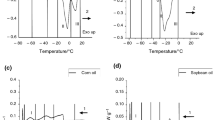Abstract
The aim of this study was to investigate the application of a mathematical model to rapid detect the adulteration in sesame, canola, and sunflower oils. To hit this target, we combined the refined sesame oil with canola and sunflower oils in different concentrations of 30–60%. Furthermore, fatty acid content of 12 samples of sesame, canola, and sunflower oils was analyzed using the gas chromatography (GC). Chromatograms were analyzed to diagnose and classify the fatty acid types. The results achieved from the experiments were analyzed using Excel 2016. The results showed that decreasing the amounts of sesame oil in different mixture oils reduces the stearic acid content and increases the amount of linolenic acid. For the model development, the mathematical model using the polynomial function was used. Finally, a mathematical formula was successfully designed to determine the amount of sesame oil in the mixture of sesame, canola, and sunflower vegetable oils (R2= 0.995). Finally, application of the mathematical models can be a quick, low-cost, and effective method to detect adulteration in sesame oils.


Similar content being viewed by others
References
Asgary S, Rafieian-Kopaei M, Najafi S, Heidarian E, Sahebkar A (2013) Antihyperlipidemic effects of Sesamum indicum L. in rabbits fed a high-fat diet. Sci World J 2013:365892
Bopitiya D, Madhujith T (2013) Antioxidant activity and total phenolic content of sesame (Sesamum indicum L.) seed oil. Trop Agric Res 24(3):296–302
Broughton R, Ruíz-Lopez N, Hassall KL, Martínez-Force E, Garcés R, Salas JJ, Beaudoin F (2018) New insights in the composition of wax and sterol esters in common and mutant sunflower oils revealed by ESI-MS/MS. Food Chem 269:70–79
Franco R, Iseppi L, Taverna M (2018) Sunflower oil functional properties for specialty food. Nutr Food Sci Int J 5(4):4–7
Gurdeniz G, Ozen B (2009) Detection of adulteration of extra-virgin olive oil by chemometric analysis of mid-infrared spectral data. Food Chem 116(2):519–525
Hama JR (2017) Comparison of fatty acid profile changes between unroasted and roasted brown sesame (Sesamum indicum L.) seeds oil. Int J Food Prop 20(5):957–967
Heidarpour M, Farhoosh R (2018) A preliminary Rancimat-based kinetic approach of detecting olive oil adulteration. LWT 90:77–82
Jiang Z, Lu X, Geng S, Ma H, Liu B (2020) Structuring of sunflower oil by stearic acid derivatives: experimental and molecular modelling studies. Food Chem 324:126801
Mohanty BP, Mahanty A, Ganguly S, Mitra T, Karunakaran D, Anandan R (2019) Nutritional composition of food fishes and their importance in providing food and nutritional security. Food Chem 293:561–570
Monteiro É, Chibli L, Yamamoto C, Pereira M, Vilela F, Rodarte M, de Oliveira Pinto M, da Penha Henriques do Amaral, M., Silvério, M., de Matos Araújo, A. (2014) Antinociceptive and anti-inflammatory activities of the sesame oil and sesamin. Nutrients 6(5):1931–1944
Ozulku G, Yildirim RM, Toker OS, Karasu S, Durak MZ (2017) Rapid detection of adulteration of cold pressed sesame oil adultered with hazelnut, canola, and sunflower oils using ATR-FTIR spectroscopy combined with chemometric. Food Control 82:212–216
Peng D, Bi Y, Ren X, Yang G, Sun S, Wang X (2015) Detection and quantification of adulteration of sesame oils with vegetable oils using gas chromatography and multivariate data analysis. Food Chem 188:415–421
Prisa S, Alizadeh M, Ghahraman N (2017) Determination of soybean oile adulteration in sesame oil by volatile organic componds profile by polypyrole-cuo nanocomposite modified polyesterfibr as a solid phase microextraction agent/gas chromatograghy. Iran J Food Sci Technol 14(67):275–284
Ribeiro SAO, Nicacio AE, Zanqui AB, Biondo PBF, de Abreu-Filho BA, Visentainer JV, Gomes STM, Matsushita M (2016) Improvements in the quality of sesame oil obtained by a green extraction method using enzymes. LWT-Food Sci Technol 65:464–470
Semenov V, Volkov S, Khaydukova M, Fedorov A, Lisitsyna I, Kirsanov D, Legin A (2019) Determination of three quality parameters in vegetable oils using potentiometric e-tongue. J Food Compos Anal 75:75–80
Seneviratne R, Young M, Beltranena E, Goonewardene L, Newkirk R, Zijlstra R (2010) The nutritional value of expeller-pressed canola meal for grower-finisher pigs. J Anim Sci 88(6):2073–2083
Seo HY, Ha J, Shin DB, Shim SL, No KM, Kim KS, Lee KB, Han SB (2010) Detection of corn oil in adulterated sesame oil by chromatography and carbon isotope analysis. J Am Oil Chem Soc 87(6):621–626
Sharma AK, Bharti S, Bhatia J, Nepal S, Malik S, Ray R, Kumari S, Arya DS (2012) Sesamol alleviates diet-induced cardiometabolic syndrome in rats via up-regulating PPARγ, PPARα and e-NOS. J Nutr Biochem 23(11):1482–1489
Sun X, Zhang L, Li P, Xu B, Ma F, Zhang Q, Zhang W (2015) Fatty acid profiles based adulteration detection for flaxseed oil by gas chromatography mass spectrometry. LWT-Food Sci Technol 63(1):430–436
Thompson L, Liu R, Jones J (1982) Functional properties and food applications of rapeseed protein concentrate. J Food Sci 47(4):1175–1180
Vasquez MC, Silva EE, Castillo EF (2017) Hydrotreatment of vegetable oils: A review of the technologies and its developments for jet biofuel production. Biomass Bioenergy 105:197–206
von Hanstein A-S, Lenzen S, Plötz T (2020) Toxicity of fatty acid profiles of popular edible oils in human EndoC-βH1 beta-cells. Nutr Diabetes 10(1):1–5
Wan Y, Li H, Fu G, Chen X, Chen F, Xie M (2015) The relationship of antioxidant components and antioxidant activity of sesame seed oil. J Sci Food Agric 95(13):2571–2578
Acknowledgements
The authors would like to thank to Neshatavar (Datis) Yazd food industry, Yazd, Iran.
Funding
This study was funded by Islamic Azad University, Yazd, Iran.
Author information
Authors and Affiliations
Corresponding author
Ethics declarations
Informed consent
Informed consent not applicable.
Conflict of interest
The authors declare no competing interests.
Additional information
Publisher’s Note
Springer Nature remains neutral with regard to jurisdictional claims in published maps and institutional affiliations.
Rights and permissions
About this article
Cite this article
Malekahmadi, R., Yasini Ardakani, S.A., Sadeghian, A. et al. Rapid Detection of Adulteration in Mixing Sesame, Sunflower, and Canola Vegetable Oils by Mathematical Model. Food Anal. Methods 14, 1456–1463 (2021). https://doi.org/10.1007/s12161-021-01980-y
Received:
Accepted:
Published:
Issue Date:
DOI: https://doi.org/10.1007/s12161-021-01980-y




